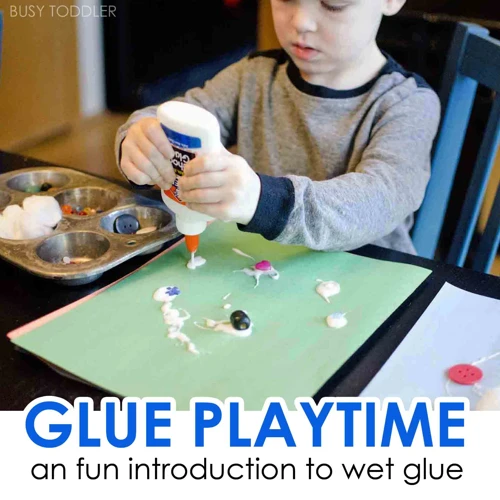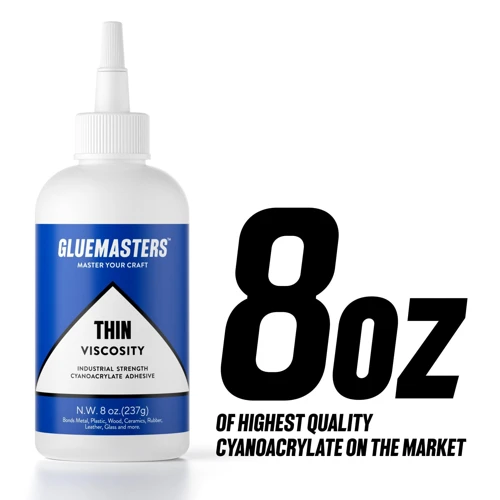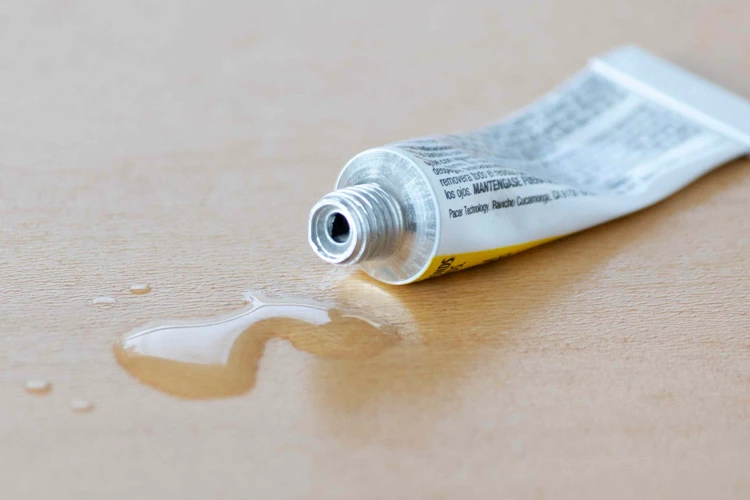Introduction
When it comes to fixing things, one of the most useful tools in your arsenal is super glue. However, there are times when even the strongest adhesive can become too thick to use effectively. That’s where thinning super glue comes in. In this guide, we’ll take you through everything you need to know about thinning super glue, including why you might need to do it, how to do it, some useful tips and tricks, and more. So grab your materials and let’s get started!
What is Super Glue?
Super glue is a fast-setting and extremely strong adhesive that is commonly used in various crafting, woodworking, and DIY projects. This type of glue is also known as cyanoacrylate glue, and it is made by combining cyanide and acrylate. Once applied, it bonds surfaces together by undergoing a process known as polymerization. During polymerization, it reacts with the moisture in the air and forms strong chemical bonds within seconds, creating a solid and durable attachment.
Here are some interesting facts about super glue:
- Super glue was first discovered during World War II, where it was used to create clear gun sights for the soldiers.
- It was originally intended as a quick and easy way to close up wounds in the battlefield.
- Super glue has a long shelf life and can last for months or even years if stored correctly in a cool and dry place.
- It can bond almost any surface, including plastic, wood, metal, glass, and even skin (although using super glue on skin is not recommended).
- Super glue has a unique ability to bond quickly, making it an ideal choice for repairing broken items or sealing small cracks and gaps.
If you’re interested in learning more about adhesives, you can check out our article on what does curing glue mean or for crafting, visit how to make glue sponges.
Why Thin Your Super Glue?
Why Should You Thin Your Super Glue?
Thinning your super glue can make it easier to work with and increase its effectiveness. When using thick super glue, it can be difficult to apply it evenly or get it into tight spaces. By thinning your super glue, you can improve its flow and penetration, allowing you to achieve a more even distribution. Thinning super glue can also extend the working time, which is helpful if you need a bit more time to adjust the positioning of the item you’re bonding. Additionally, it can help to reduce the risk of bonding failure or cracking over time.
Benefits of Thinning Super Glue
Thinning super glue can be very beneficial in certain circumstances. The following table highlights some of the top benefits of thinning super glue:
| Benefit | Description |
| Improved Penetration | Thinned super glue can penetrate porous materials more effectively, ensuring a stronger bond. |
| Enhanced Flow | Thinning super glue can help it flow more easily, making it ideal for filling gaps and cracks. |
| Faster Drying | Thinned super glue can dry faster than un-thinned glue, making it a great choice for time-sensitive projects. |
| Reduced Brittleness | Un-thinned super glue can become brittle and prone to cracking over time. Thinning can help counteract this effect. |
| Improved Adhesion | Thinning super glue can help it adhere to a wider range of materials, making it more versatile and useful. |
By thinning your super glue, you can reap these benefits and achieve a stronger, more durable bond. Whether you’re gluing vellum to paper (link to relevant anchor) or tying an elastic bracelet without glue (link to relevant anchor), thinning your super glue can make the process easier and more effective.
How to Thin Your Super Glue
In order to ensure a strong and durable bond, it’s important to use the right consistency of super glue for the task at hand. If your super glue is too thick, it may not penetrate the materials properly, resulting in a weak bond. That’s why knowing how to thin your super glue is an essential skill for any DIY enthusiast or professional. In this section, we’ll go over several ways to thin your super glue to the perfect consistency using simple materials that you probably already have at home. So let’s get started!
What You Will Need
When it comes to thinning super glue, there are a few items you will need to prepare in advance. It is important to collect all the necessary tools and materials before starting the process to ensure that everything goes smoothly. Here are the items you will need:
- Super Glue: Obviously, you will need the super glue that you plan to thin.
- Acetone: This is the most common and effective substance used to thin super glue. You can find acetone at most hardware stores, or even in nail polish remover.
- Small container: You will need a small container (a glass jar or bowl works well) to mix the super glue and acetone together.
- Measuring tool: Depending on the method you choose, you may need some type of measuring tool to ensure you get the correct ratio of super glue to acetone.
- Stirring utensil: You will need something to stir the mixture with. A small spoon or toothpick works well for this.
- Paper towels: Keep some paper towels handy to quickly clean up any spills or drips that may occur during the thinning process.
Remember to work in a well-ventilated area and to wear gloves when handling acetone, as it can be harsh on skin. Once you have all the necessary materials, you can move on to the next step of thinning your super glue.
If you want to learn more about glueing, check out the article on How to Glue Up Boards.
Step by Step Instructions
Thinning your super glue is a great way to get the perfect consistency for your project. Follow these step-by-step instructions to get it done effortlessly.
| Step 1: | Gather your materials. You will need your super glue, acetone, and a container to mix them in. It’s important to have the right amount of each ingredient to get the perfect consistency. |
| Step 2: | Prepare your workspace. Make sure your workspace is clean and clear of any distractions. Also, it’s important to wear gloves to protect your hands from the acetone. |
| Step 3: | Add the super glue to the container. You’ll need to measure the amount of super glue you want to thin out. Use a spoon or any other tool to transfer the super glue to the container. |
| Step 4: | Add acetone. Once you’ve added the super glue, add a small amount of acetone to it as well. It’s important to add small amounts at a time to get the desired consistency. You don’t want to add too much and end up with runny super glue. |
| Step 5: | Stir the mixture. Use a small tool or utensil to mix the super glue and acetone together. Make sure to mix them well to get an even consistency. |
| Step 6: | Test the consistency. Once you’ve mixed the super glue and acetone, test the consistency. If it’s still too thick, add a little more acetone. If it’s runny, add a little more super glue. Keep testing and adjusting until you reach the desired consistency. |
| Step 7: | Use your thinned super glue. Your thinned super glue is now ready to be used. Apply it to your project carefully and wait for it to dry. |
Remember that each project is different, so you may need to tweak your ratio of acetone and super glue accordingly. If you want to learn more about glue, you can check out how to dry Elmer’s glue fast or read up on how to make your own glue.
Tips and Tricks
When it comes to using super glue, there are always tips and tricks that can come in handy. Whether you’re an experienced user or a beginner, these tips can help you avoid mistakes and make the most out of your super glue. Not only will these tricks make your gluing projects easier, but they can also help you save time and money in the long run. So, let’s dive into some of the most useful tips and tricks for working with super glue. And if you’re interested in crafting without glue, check out this tutorial on how to make a paper bag without glue.
Avoiding Common Mistakes
Avoiding Common Mistakes when Thinning Super Glue is crucial to achieving a successful outcome. Here are some common mistakes that people make and tips on how to avoid them:
| Mistake | How to Avoid |
| Adding too much solvent | Remember to add the solvent slowly, a little bit at a time. This will help to prevent over-thinning and ensure that the super glue still sets properly. |
| Using the wrong solvent | Make sure to use the correct solvent for the type of super glue you are using. Using the wrong solvent can cause the glue to not set properly or even damage the materials you are trying to bond. |
| Not mixing the solvent properly | In order to ensure that the solvent is properly mixed, stir the super glue and solvent mixture thoroughly. This will help to prevent uneven thinning and clumps of undissolved super glue. |
| Not letting the glue dry completely | Super glue needs time to set properly in order to bond materials together. Make sure to give it enough time to dry according to the manufacturer’s instructions. If you have any questions on setting time refer to What Super Glue Dries Clear? |
| Not clamping the materials together | Clamping the materials together will help to ensure a secure bond. Make sure to apply even pressure to the materials and keep them clamped for the correct amount of time. If you have any questions on clamping refer to How Long to Keep Wood Glue Clamped? |
By avoiding these common mistakes, your Super Glue will be thinned successfully, and the bonding process will be easy and effective.
Other Ways to Thin Super Glue
While acetone and baking soda are the most popular options for thinning super glue, there are other alternatives you can use. Here are some other ways to thin super glue:
| Rubbing Alcohol | White Vinegar |
|---|---|
| Rubbing alcohol contains isopropyl alcohol which can weaken the bond of the super glue. Simply apply some rubbing alcohol on the surface and gently rub it with a soft cloth. Repeat until the glue is thinned to your desired consistency. | White vinegar can also be used to thin super glue. It works by breaking down the bond between the glue and the surface. Mix equal parts of white vinegar and water in a bowl and apply it to the glue using a cotton swab or cloth. Repeat as necessary until the glue is thinned. |
| Lemon Juice | Hot Water |
| Lemon juice contains citric acid which can help weaken the bond of the super glue. Squeeze some lemon juice on the glue and let it sit for a few minutes. Use a cotton swab or cloth to rub the glue until it is thinned. | Hot water can also be used to thin super glue. Place the glued object in a bowl of hot water for a few minutes. This will soften the glue and make it easier to remove excess glue or adjust its consistency. |
It’s important to note that some of these alternatives may not work as effectively as acetone or baking soda and may take longer to achieve the desired results. It’s also essential to use caution when trying these methods, especially when handling hot water or acidic solutions like lemon juice or vinegar, as they may damage certain surfaces. However, experimenting with different thinning techniques can be a fun and creative way to handle super glue mishaps.
Conclusion
After reading this article, you should now have a better understanding of how to thin super glue by using simple items that are readily available at home. By following the step-by-step instructions, you can ensure that your super glue is just the right consistency for your project, giving you better control and a cleaner finish.
Remember that thinning your super glue can save you time and money by reducing the likelihood of blobs and messy glue messes. Thinning also helps the glue to bond more evenly and effectively, improving the overall strength of your project.
In conclusion, always remember to ventilate the area when working with super glue, as it can release fumes that can be harmful if inhaled. Be sure to protect your skin and work surface as well. With a little practice and patience, you can achieve professional-looking results that will make your projects stand out.
Frequently Asked Questions
Can super glue be used on all materials?
No, super glue works best on non-porous materials such as plastic, metal, and glass. It may not work as well on porous materials like fabric or wood.
Is it safe to thin super glue with acetone?
Yes, acetone is a safe and effective way to thin super glue. However, it is important to use it in a well-ventilated area and avoid skin contact.
What happens if I don’t thin my super glue?
Super glue that is not thinned may dry too quickly or form clumps, making it difficult to use or resulting in a weak bond.
How much acetone should I use to thin my super glue?
Start with a small amount, such as a few drops of acetone per ounce of super glue. You can always add more if needed, but be careful not to use too much.
Can I use water to thin my super glue?
No, water is not effective at thinning super glue as it will cause the glue to harden and clump.
What if I accidentally use too much acetone?
If you accidentally add too much acetone, the glue may become too thin and lose its effectiveness. Try adding more super glue to thicken the mixture.
Can I store thinned super glue?
Thinned super glue has a shorter shelf life than unthinned glue, but it can be stored in an airtight container for a few weeks.
Can I thin super glue with rubbing alcohol?
Rubbing alcohol can be used to thin super glue, but it is not as effective as acetone and may result in a weaker bond.
Can I use a hairdryer to speed up the drying process?
Yes, using a hairdryer on low heat can speed up the drying process of thinned super glue. However, be careful not to overheat the glue as it may cause it to bubble or dry too quickly.
How long should I wait for the thinned super glue to dry?
Thinned super glue may dry faster than unthinned glue. However, it is best to wait at least 24 hours for it to fully cure before using the bonded object.


